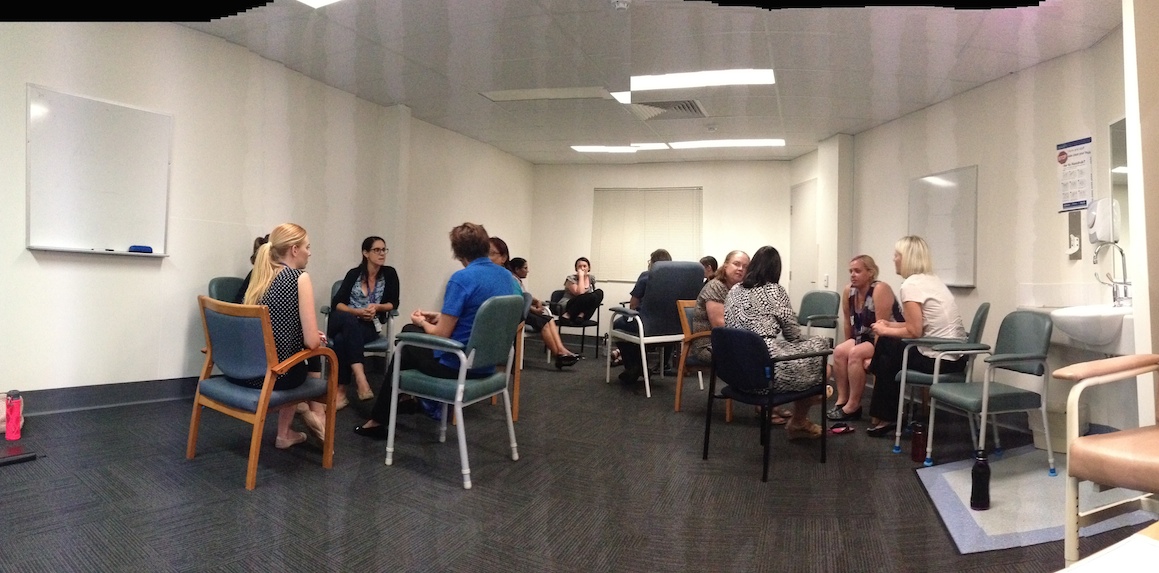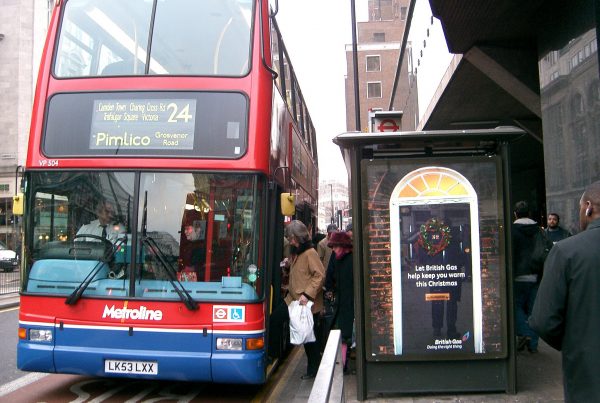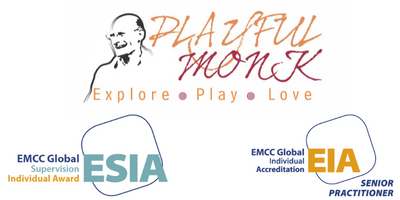In the distance I hear the gut wrenching noise of a patient being sick, my bodies early warning nervous system goes up a notch, my senses become alert and orientate towards the noise. I bring my attention back to my breath and my bodily sensations, as I facilitate a guided mindfulness mediation session. This is being held in the day room on the Rehab ward for geriatrics at Armadale hospital with twenty staff ranging from consultants to admin. At the same time alarms go off, people come to make tea in the day room and yet I find myself and the people around me orientating towards relaxation.
Don’t touch that button
I went to Armadale hospital as part of my monk in residence program. The program lasted for a week and I lived in a room in the hospital. Armadale is on the south-eastern edge of Perth’s metropolitan area and has an image of being in a low social economic area. In previous years I ran a mindfulness based parenting class in a counselling centre in the same area, where some of the kids did not get enough food to eat. As I settled in my room I was surprised to experience a lot of stillness and peace. My room was self contained with kitchen, toilet, hospital bed and an emergency switch. On the first evening I accidentally knocked and wondered if half the hospital staff would be flocking to my room to resuscitate the monk. Luckily I noticed the cancel button underneath it, which is similar to what mindful ness can offer to our internal alarm system. As I was close to the patients I could hear one man coughing and my concern about his welfare arose and my thoughts of lack of sleep. Living in a monastery in the Britain for over ten years in similar shared accommodation with flimsy walls on a busy corridor, I was used to this type of sound. And so my first night’s sleep was very restful, once I had accepted that this is part of the environment I’m in at the moment.

Being your own Intensive Care Unit.
The following morning I was taken around the various departments by Dr.N.Waldron who had championed the project and created a committee to support my stay there. As we entered the small intensive care unit I felt my heart rate go up and noticed how I wanted to hold my breath. What would I see or hear?
As I was introduced to the clinicians, there was a barrage of jokes and then the matter of fact way of recalling what happened last night with a patient, it was not pleasant. This really helped me to understand what it is like be on the receiving side of medical health care. Each day consisted of guided mindfulness session, short 1 to 1 session for personal issues and being in the hospital foyer to connect with staff and for mindfulness based themed workshops (full program here).
The focus of my work was to bring the biology and neuroscience of how the body responds to stress and trauma, whilst making it playful to explore how mindfulness can support wellbeing and be included in a daily busy life. Health and welfare support workers in recent research where rated the fifth most stressful job in Australia. Mindfulness (link to definition) can be introduced in a short period of time and it is still like a muscle which requires to be used. I have personally found that the six to eight week course (which I call stress to freedom – link) is the best way to learn this and I have received a lot of good feedback on how people have benefited from this.
Exploring the morning breath
At eight in the morning I would sit in the quiet room of the hospital with the door open and staff would enter for ten minutes of sitting practise. Other staff where coming to work and the corridor was noisy, people talking, doors banging and other staff coming in a bit late to sit. Although the session was only for ten minutes, there was a sense of arriving for a days work. Rather than trying to be in a quiet place or exclude noise, I encouraged an attitude of inclusivity. Allowing the sounds to touch us and using that as way to bring oneself back to the present moment. As I allowed myself this, the attention naturally went back to the breath and I really noticed the neutral quality of the breath: the peacefulness of the breath. We did the same in the evening for those staff which where around, allowing the day to finish and leaving the hospital refreshed.
Joyous work
Meeting the staff I really got to see how much they loved to be at their jobs and care for the patients. This was expressed by some staff who travelled long distances to work and others working at the hospital for many years. It was so joyous to be part of this and I think it reflects the wider support of the executive of the hospital (something which is important in employee engagement). When I first met the executive of the hospital I was surprised by their willingness to engage in the project. There was a lot of practicalities to organise, including a MRSA swab up the nose. All of this was all organised over a few months.
“Opportunity to bring humanity and mindfulness to the hospital in a deeper sense gives me total satisfaction.”
feedback participant
Role play
A lot of the feedback I got was that the staff felt really encouraged/supported that this program could go ahead and they had time to connect beyond the roles, even when that was difficult in the first instance. Its seems to me that being in a role creates difficulty and masks our humanness, something which is very important when dealing with compassion fatigue and something I have developed in myself. Being in a room where a diverse range of staff spoke to each other about the limitations was inspiring and allowed for that deeper connection we all look for. Partly I see my role as creating a safe space for that interaction to happen. As the week went by I was also keenly aware that I also needed to help staff get back into role before they left the session.
“A world-first survey of thousands of Australian doctors and medical students
has revealed they are burnt-out, more likely to experience
psychological distress and suicidal thoughts
than the general community and are drinking too much alcohol.”
“43% of medical students have a high likelihood of experiencing
a minor psychiatric disorder and 9.2% have very high levelsof psychological distress.
The general community mean score for high psychological distress is 2.6%”
from Beyond blue
During my first public talk for the hospital one of the question I asked the audience, was to define mental health, something that brought a coldness to the room. This theme seemed to under pin the week, that understanding how our mind and body respond to stress, some of which is under the cognitive radar is an important stage in taking responsibility for our lives and in recognising peace.

“I loved how you guided the session and paced the group
from an external framework
towards curiosity and self enquiry – loved the videos.”
feedback participant
Playful structures
The interactive workshops gave time for staff to explore mindfulness through the lens of compassion, fatigue, leadership, parenting and community. During these workshops I noticed that a lot of medical life seems to be around structure and procedure, which can be very helpful in terms of looking after the well-being of the patient and the smooth running of large organisation. It can also lead to rigidity and not being able to respond to what is actually happening as the procedure/structure overrides our neurobiology to deal with stress and natural capacity to deal with life. My style of facilitation allows for this and so for some staff this was confronting to be where the fundamental learning outcome was to be with exactly what was going on at the moment. Mixing this with procedural/structures information from science or other people’s learning, provides both the flexibility to be with what is happening and include best practises. Something I learnt from my days of building expert systems when I studied Artificial intelligence: just giving computers facts and procedures does not produce wisdom.
Old age, sickness, death
This program was from the outset a secular program I brought my years of monastic discipline, developing community spaces, living an ethical life and mindfulness practise to this environment. I consider the monastic form a type of moveable art form. When we go to a art gallery we can start to have strange thoughts, how dare they do that, I like that and so on. Sitting in the foyer of the hospital was a bit like this, it gave an opportunity for staff to engage and for me to be mindful of my thoughts and bodily feelings, whether people engaged or not. Everybody has a choice, whether people know that or not is a matter of mindfulness. In Buddhist cosmology there are pointers which can trigger us to reflect on our lives: old age, sickness, death and monasticism, which is something I felt sitting in the foyer and especially when I spoke with staff from Accident and Emergency. The foyer space and meeting people 1 to 1, was an enactment of siting around the fire, telling our stories and for them to be received without judgement, something we can all offer to each other once we move way from being overwhelmed and develop healthy boundaries. I was amazed and grateful for the opportunity to meet the staff and see their care, humour, curiosity and tenacity to what life presents them.
Love and Support
The final slide I showed on most of my presentations was with the following quote
A wise physician said, “The best medicine for Humans is LOVE.”
Someone asked, “What if it doesn’t work?”
He smiled and answered, “Increase the dose.”
Over the week probably three hundred people came to my workshops and talks. In order to do offer this work I have needed to put in place exactly what I share about finding support, engaging in other activities outside of what I normally do and having an embodied mindfulness practise, releasing trauma and recognising peace.
Testimonial for Venerable Amaranatho
From Chris Bone
Executive Director
Armadale Health Service
“We were recently privileged to host Venerable Amaranatho as part of a one-week
monk-in-residence program aimed at
supporting and improving the mental wellbeing of our staff.
Feedback from participants have been overwhelmingly positive and staff
have commented on the benefits of the one-on-one sessions and group workshops.
We strongly believe workplace health has a direct relationship with our
work/life balance and organisational productivity
and we would like to thank Venerable Amaranatho
for facilitating the week-long mindfulness program.”
Full Evaluation here done by Dr.N.Waldron, Chair, Organising Committee
From the participants
interconnection of biology, psychology and practise.
discussion with colleagues – thought provoking
very down to earth presenter
The program I offered can be download as PDF here (includes description of each workshop)
Program agreements between myself and the hospital can be download as PDF here
Links
guided meditation here long and short
Australia’s most stressed professions
http://www.roymorgan.com/findings/5852-australias-most-stressed-professions-201410072147
The research about mindfulness
A Randomized, Controlled Trial of Meditation for Work Stress, Anxiety and Depressed Mood in Full-Time Workers
http://www.hindawi.com/journals/ecam/2011/960583/
Why is mindfulness helpful in medical care
https://goamra.org/mbsr-trainees-use-fewer-healthcare-resources/
Speaking about mental health at work
http://www.headsup.org.au/taking-care-of-myself-at-work/talking-about-a-mental-health-condition-at-work/how-to-talk-about-it
Original article at from playfulmonk here


